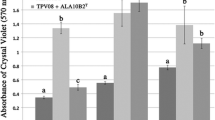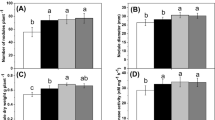Abstract
The aim of this work was to assess the effect of inoculation with the non-symbiotic Agrobacterium strain 10C2, previously isolated from root nodules of Phaseolus vulgaris, on nodulation, effectiveness and host range specificity. Two rhizobial strains, Ensifer meliloti 2011 and Ensifer medicae A321, were used in this study on the basis of their differential sensitivity to the in vitro antagonistic activity exercised by Agrobacterium sp. 10C2. Three host legumes, P. vulgaris, Medicago laciniata and M. polymorpha, were also selected for this experiment on the basis of their variable symbiotic specificity towards strains 2011 and A321. Cross inoculation experiments were conducted with or without co-inoculation with Agrobacterium sp. 10C2. Results showed that both rhizobial strains induced ineffective nodules on P. vulgaris. Nevertheless, inoculation with Agrobacterium sp. 10C2 slightly increased shoot dry weight with both strains and enhanced nodule number with strain 2011 only. Inoculation of M. polymorpha with strain 10C2 significantly increased the nodule number induced by E. medicae A321 but did not affect biomass production. However, inoculation of M. laciniata by strain 10C2 enhanced nodule number and shoot dry weight with strain 2011 only. Agrobacterium sp. 10C2 did not affect the non-inoculated control, nor the contrasted host range of both rhizobial strains towards M. polymorpha and M. laciniata. The potential negative effect of the in vitro antagonistic activity of strain 10C2 on reduction of nodule number or symbiotic effectiveness was not proved. No evidence of symbiotic gene transfer from the rhizobial strains to Agrobacterium sp. 10C2 was also proved. The effect of strain 10C2 is probably mediated by nodules since no result was observed in the non-inoculated control or when the rhizobial strain failed to induce nodules. It would be interesting to investigate the implications on nodule functioning, mainly the impact on nitrogenase activity, antioxidant enzymes and nodule senescence.



Similar content being viewed by others
References
Alexandre A, Laranjo M, Oliveira S (2006) Natural populations of chickpea rhizobia evaluated by antibiotic resistance profiles and molecular methods. Microbial Ecol 51:128–136
Balachandar D, Raja P, Kumar K, Sundaram SP (2007) Non-rhizobial nodulation in legumes. Biotechnol Mol Biol Rev 2:049–057
Ben Romdhane S, Aouani ME, Mhamdi R (2007) Inefficient nodulation of chickpea (Cicer arietinum L.) in the arid and Saharan climates in Tunisia by Sinorhizobium meliloti biovar medicaginis. Ann Microbiol 57:15–19
Ben Romdhane S, Trabelsi M, Aouani ME, de Lajudie P, Mhamdi R (2009) The diversity of rhizobia nodulating chickpea (Cicer arietinum) under water deficiency as a source of more efficient inoculants. Soil Biol Biochem 41:2568–2572
Berggren I, Alström S, van Vuurde JWL, Mårtensson AM (2005) Rhizoplane colonisation of peas by Rhizobium leguminosarum bv. viciae and a deleterious Pseudomonas putida. FEMS Microbiol Ecol 52:71–78
Beringer JE (1974) R factor transfer in Rhizobium leguminosarum. J Gen Microbiol 84:188–198
Brockwell J, Hely FW (1966) Symbiotic characteristics of Rhizobium meliloti: an appraisal of the systematic treatment of nodulation and nitrogen fixation interactions between hosts and rhizobia of diverse origins. Aust J Agric Res 17:885–899
Cevheri C, Küçük C, Çetin E (2011) Fungicide, antibiotic, heavy metal resistance and salt tolerance of root nodule isolates from Vicia palaestina. Afr J Biotechnol 10:2423–2429
Cummings SP, Gyaneshwar P, Vinuesa P, Farruggia FT, Andrews M, Humphry D et al (2009) Nodulation of Sesbania species by Rhizobium (Agrobacterium) strain IRBG74 and other rhizobia. Environ Microbiol 10:2510–2525
De la Fuente L, Thomashow L, Weller D, Bajsa N, Quagliotto L, Chernin L, Arias A (2004) Pseudomonas fluorescens UP61 isolated from birdsfoot trefoil rhizosphere produces multiple antibiotics and exerts a broad spectrum of biocontrol activity. Eur J Plant Pathol 110:671–681
De Lajudie P, Willems A, Nick G, Mohamed SH, Torck U, Coopman R, Filali-Maltouf A, Kersters K, Dreyfus B, Lindstrom K, Gillis M (1999) Agrobacterium bv. 1 strains isolated from nodules of tropical legumes. Syst Appl Microbiol 22:119–132
Dileep Kumar BS, Berggren I, Maartensson AM (2001) Potential for improving pea production by coinoculation with fluorescent Pseudomonas and Rhizobium. Plant Soil 229:25–34
Egamberdieva D, Berg G, Lindström K, Räsänen LA (2010) Co-inoculation of Pseudomonas spp. with Rhizobium improves growth and symbiotic performance of fodder galega (Galega orientalis Lam.). Eur J Soil Biol 46:269–272
Franzini VI, Azcon R, Mendes FL, Aroca R (2010) Interactions between Glomus species and Rhizobium strains affect the nutritional physiology of drought-stressed legumehosts. J Plant Physiol 167:614–619
Hassanein WA, Awny NM, El-Mougith AA, El-Dien SH (2009) The antagonistic activities of some metabolites produced by Pseudomonas aeruginosa Sha8. J Appl Sci Res 5:404–414
Hungria M, de O’Cheuerie LM, Coca RG, Megias M (2001) Preliminary characterization of fast growing rhizobial isolated from soyabean nodules in Brazil. Soil Biol Biochem 33:1349–1361
Ibanez F, Angelini J, Taurian T, Tonelli ML, Fabra A (2009) Endophytic occupation of peanut root nodules by opportunistic Gammaproteobacteria. Syst Appl Microbiol 32:49–55
Kan FL, Chen ZY, Wang ET, Tian CF, Sui XH, Chen WX (2007) Characterization of symbiotic and endophytic bacteria isolated from root nodules of herbaceous legumes grown in Qinghai–Tibet plateau and in other zones of China. Arch Microbiol 188:103–115
Laguerre G, Nour SM, Macheret V, Sanjuan J, Drouin P, Amarger N (2001) Classification of rhizobia based on nodC and nifH gene analysis reveals a close phylogenetic relationship among Phaseolus vulgaris symbionts. Microbiology 147:981–993
Lal S, Tabacchioni S (2009) Ecology and biotechnological potential of Paenibacillus polymyxa: a mini review. Indian J Microbiol 49:2–10
Lei X, Wang ET, Chen WF, Sui XH, Chen WX (2008) Diverse bacteria isolated from root nodules of wild Vicia species grown in temperate region of China. Arch Microbiol 190:657–671
Li JH, Wang ET, Wen FC, Wen XC (2008) Genetic diversity and potential for promotion of plant growth detected in nodule endophytic bacteria of soybean grown in Heilongjiang province of China. Soil Biol Biochem 40:238–246
Liu J, Wang ET, Ren DW, Chen WX (2010) Mixture of endophytic Agrobaterium and Sinorhizobium meliloti strains could induce non specific nodulation on some woody legumes. Arch Microbiol 192:229–234
Mahdhi M, Mars M (2006) Genotypic diversity of rhizobia isolated from Retama raetam in arid regions of Tunisia. Ann Microbiol 56:305–311
Mhamdi R, Jebara M, Aouani ME, Ghrir R, Mars M (1999) Genotypic diversity and symbiotic effectiveness of rhizobia isolated from root nodules of Phaseolus vulgaris L. grown in Tunisian soils. Biol Fertil Soils 28:313–320
Mhamdi R, Laguerre G, Aouani ME, Mars M, Amarger N (2002) Different species and symbiotic genotypes of field rhizobia can nodulate Phaseolus vulgaris in tunisian soils. FEMS Microbiol Ecol 41:77–84
Mhamdi R, Mrabet M, Laguerre G, Tiwari R, Aouani ME (2005) Colonization of Phaseolus vulgaris nodules by Agrobacterium-like strains. Can J Microbiol 51:105–111
Mishra PK, Mishra S, Selvakumar G, Bisht JK, Kundu S, Gupta HS (2009) Coinoculation of Bacillus thuringeinsis-KR1 with Rhizobium leguminosarum enhances plant growth and nodulation of pea (Pisum sativum L.) and lentil (Lens culinaris L.). World J Microbiol Biotechnol 25:753–761
Mrabet M, Mnasri B, Ben Romdhane S, Laguerre G, Aouani ME, Mhamdi R (2006) Agrobacterium strains isolated from root nodules of common bean specifically reduce nodulation by Rhizobium gallicum. FEMS Microbiol Ecol 56:304–309
Murugesan S, Manoharan C, Vijayakumar R, Panneerselvam A (2010) Isolation and characterization of Agrobacterium rhizogenes from the root nodules of some leguminous plants. Intl J Microbiol Res 1:92–96
Oresnick IJ, Twelker S, Hynes MF (1999) Cloning and characterization of a Rhizobium leguminosarum gene encoding a bacteriocin with similarities to RTX toxins. Appl Environ Microbiol 65:2833–2840
Palaniappan P, Chauhan PS, Saravanan VS, Anandham R, Tongmin S (2010) Isolation and characterization of plant growth promoting endophytic bacterial isolates from root nodule of Lespedeza sp. Biol Fertil Soils 46:807–816
Rajendran G, Sing F, Desai AJ, Archana G (2008) Enhanced growth and nodulation of pigeon pea by coinoculation of Bacillus strains with Rhizobium spp. Bioresour Technol 99:4544–4550
Remans R, Ramaekers L, Schelkens S, Hernandez G, Garcia A, Reyes JL, Mendez N, Toscano V, Mulling M, Galvez L, Vanderleyden J (2008) Effect of Rhizobium–Azospirillum coinoculation on nitrogen fixation and yield of two contrasting Phaseolus vulgaris L. genotypes cultivated across different environments in Cuba. Plant Soil 312:25–37
Robledo M, Jiménez-Zurdo JI, Velázquez E, Trujillo ME, Zurdo-Piñeiro JL, Ramirez-Bahena MH, Ramos B, Díaz-Mínquez JM, Dazzo F, Martínez-Molina E, Mateos PF (2008) Rhizobium cellulase CelC2 is essential for primary symbiotic infection of legume host roots. Proc Natl Acad Sci USA 105:7064–7069
Rome S, Fernandez MP, Brunel B, Normand P, Cleyet-Marel JC (1996) Sinorhizobium medicae sp. nov., isolated from annual Medicago spp. Int J Syst Bacteriol 46:972–980
Saïdi S, Mnasri B, Mhamdi R (2011) Diversity of nodule-endophytic agrobacteria-like strains associated with different grain legumes in Tunisia. Syst Appl Microbiol 34:524–530
Sindhu SS, Dadarwal KR (2001) Chitinolytic and cellulolytic Pseudomonas sp. Antagonistic to fungal pathogens enhances nodulation by Mesorhizobium sp. Cicer in chickpea. Microbiol Res 156:353–358
Stajković O, De Meyer S, Miličić B, Willems A, Delić D (2009) Isolation and characterization of endophytic non-rhizobial bacteria from root nodules of alfalfa (Medicago sativa L.). Botanica Serbica 33:107–114
Stockwell VO, Stack JP (2007) Using Pseudomonas spp. for integrated biological control. Phytopathology 97:244–249
Sturz AV, Christie BR, Matheson BJ, Nowak J (1997) Biodiversity of endophytic bacteria which colonize red clover nodules, roots, stems and foliage and their influence on host growth. Biol Fertil Soils 25:13–19
Tokola RK, Strap JL, Jung CM, Crawford DL, Salove MH, Deobald A, Bailley JF, Morra MJ (2002) Novel plant-microbe rhizosphere interaction involving Streptomyces lydicus WYEC108 and the pea plant (Pisum sativum). Appl Environ Microbiol 68:2161–2171
Vadez V, Rodier F, Payre H, Drevon JJ (1996) Nodule permeability to O2 and nitrogenase-linked respiration in bean genotypes varying in the tolerance of N2 fixation to P deficiency. Plant Physiol Biochem 34:871–878
Villegas MDC, Rome S, Mauré L, Domerguea O, Gardan L, Bailly X, Cleyet-Marel JC, Brunel B (2006) Nitrogen-fixing sinorhizobia with Medicago laciniata constitute a novel biovar (bv. medicaginis) of S. meliloti. Syst Appl Microbiol 29:526–538
Vincent JM (1970) A manual for the practical study of root nodule bacteria. IBP handbook, no. 15. Blackwell, Oxford
Wang LL, Wang ET, Liu J, Li Y, Chen WX (2006) Endophytic occupation of root nodules and root of Melilotus dentatus by Agrobacterium tumefaciens. Microbiol Ecol 52:436–443
Weisburg W, Barns SM, Pelletier DA, Lane DJ (1991) 16S ribosomal DNA amplification for phylogenetic study. J Bacteriol 173:697–703
Zakhia F, Jeder H, Willems A, Gillis M, Dreyfus B, de Lajudie P (2006) Diverse bacteria associated with root nodules of spontaneous legumes in Tunisia and first report for nifH-like gene within the genera Microbacterium and Starkeya. Microbiol Ecol 51:375–393
Zhao L, Xu Y, Sun R, Deng Z, Yang W, Wei G (2011) Identification and characterization of the endophytic plant growth prompter Bacillus cereus strain MQ23 isolated from Sophora Alopecuroides root nodules. Braz J Microbiol 42:567–575
Acknowledgements
The authors wish to thank Dr. Mounawar Badri (Laboratory of Extremophile Plants, Centre of Biotechnology of Borj Cedria, Tunisia) for providing seeds of M. laciniata and M. polymorpha.
Author information
Authors and Affiliations
Corresponding author
Rights and permissions
About this article
Cite this article
Salem, S., Saidi, S., Chihaoui, SA. et al. Inoculation of Phaseolus vulgaris, Medicago laciniata and Medicago polymorpha with Agrobacterium sp. strain 10C2 may enhance nodulation and shoot dry weight but does not affect host range specificity. Ann Microbiol 62, 1811–1817 (2012). https://doi.org/10.1007/s13213-012-0439-2
Received:
Accepted:
Published:
Issue Date:
DOI: https://doi.org/10.1007/s13213-012-0439-2




